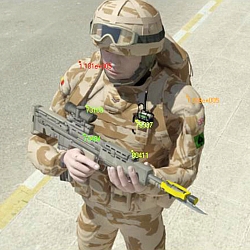
Soldier in a fictitious urban, desert environment; the superimposed numbers are readings for anticipated sunlight. (EPSRC)
A new type of personal power pack in development by six universities in the U.K. could reduce the weight troops carry when engaged on the battlefield. The solar and thermoelectric-powered system aims to weigh up to fifty per cent less than conventional chemical battery packs used by British infantry.
The two-year project is being developed by the Universities of Glasgow, Loughborough, Strathclyde, Leeds, Reading and Brunel, with funding from the Engineering and Physical Sciences Research Council (EPSRC), and supported by the Defence Science and Technology Laboratory.
This new project differs from previous research on adapting solar power for combat troops by adding thermoelectric devices to complement solar cells. The project team is also investigating how both types of power-generating device could be woven into soldiers’ battle dress. A key aim of the project team, however, is to develop a system specifically for military use in tough, hostile conditions.
During the day, the solar cells will produce electricity to power equipment. At night, the thermoelectric devices will take over and perform the same function. The system will also incorporate advanced energy storage devices to ensure electricity is always available.
Thermoelectric devices create power from temperature differences between two metals or two semiconductors. In this application, the devices would generate power by using the difference in temperature between the outside and the inside of a soldier’s battle dress.
The research team aims to produce nanostructured photovoltaic and thermoelectric films on conventional rigid underlying layers separately, and then together. In the next step, the researchers plan to repeat the process using flexible substrates. If the development of these flexible hybrid power devices is successful, they could then be colored with camouflage when worn in the field.
Read More: Academics, Company Develop High-Performance Nanotech Fiber
* * *

 RSS - Posts
RSS - Posts
Electricity from solar thermal collectors can any one tell me how?
Thanks for your question and visiting Science Business. Try this page for starters …
http://www.eia.doe.gov/cneaf/solar.renewables/page/solarreport/solar.html
– Alan